Competitive Strategy Case Study 2022
VerifiedAdded on 2022/09/30
|12
|2350
|36
AI Summary
Contribute Materials
Your contribution can guide someone’s learning journey. Share your
documents today.
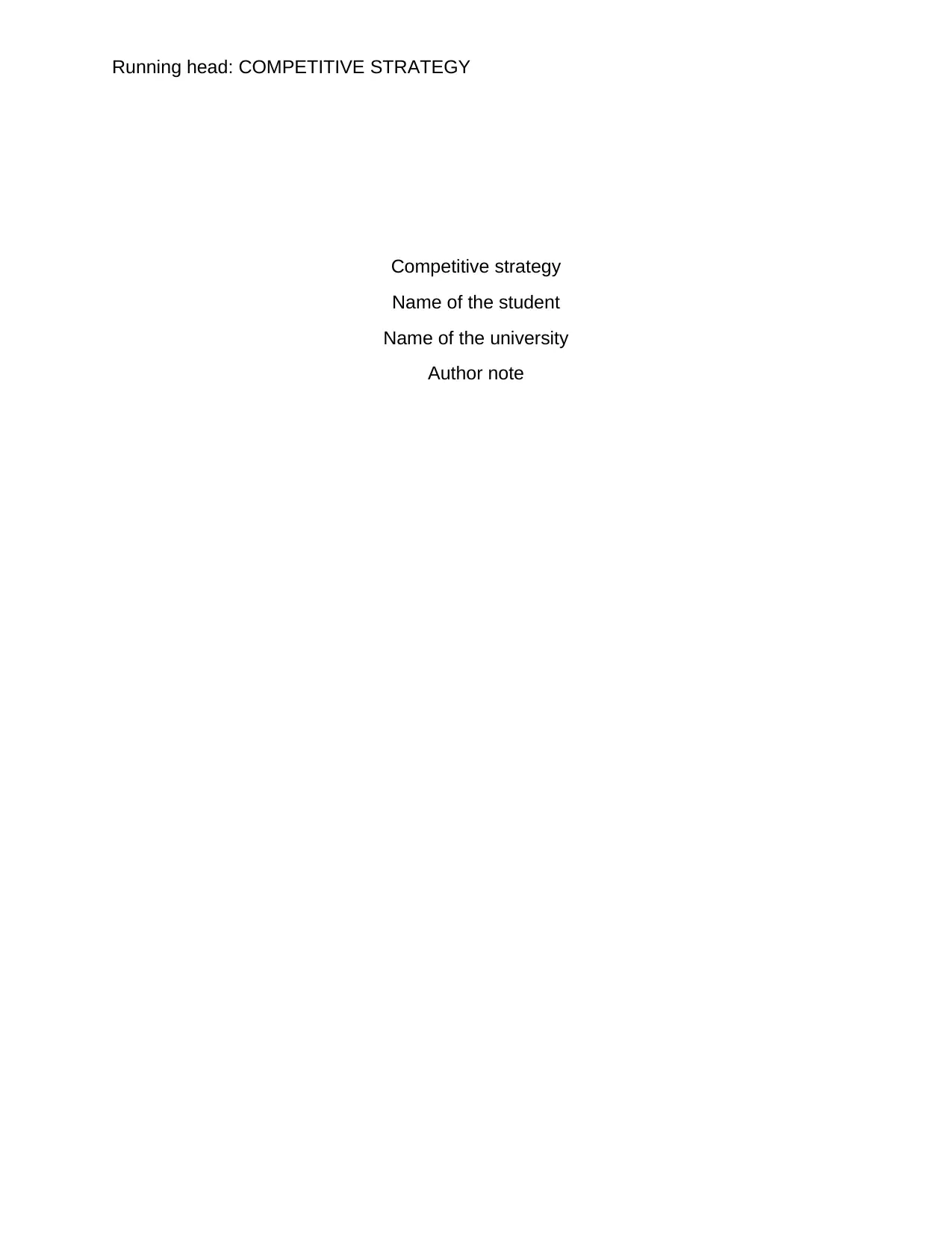
Running head: COMPETITIVE STRATEGY
Competitive strategy
Name of the student
Name of the university
Author note
Competitive strategy
Name of the student
Name of the university
Author note
Secure Best Marks with AI Grader
Need help grading? Try our AI Grader for instant feedback on your assignments.
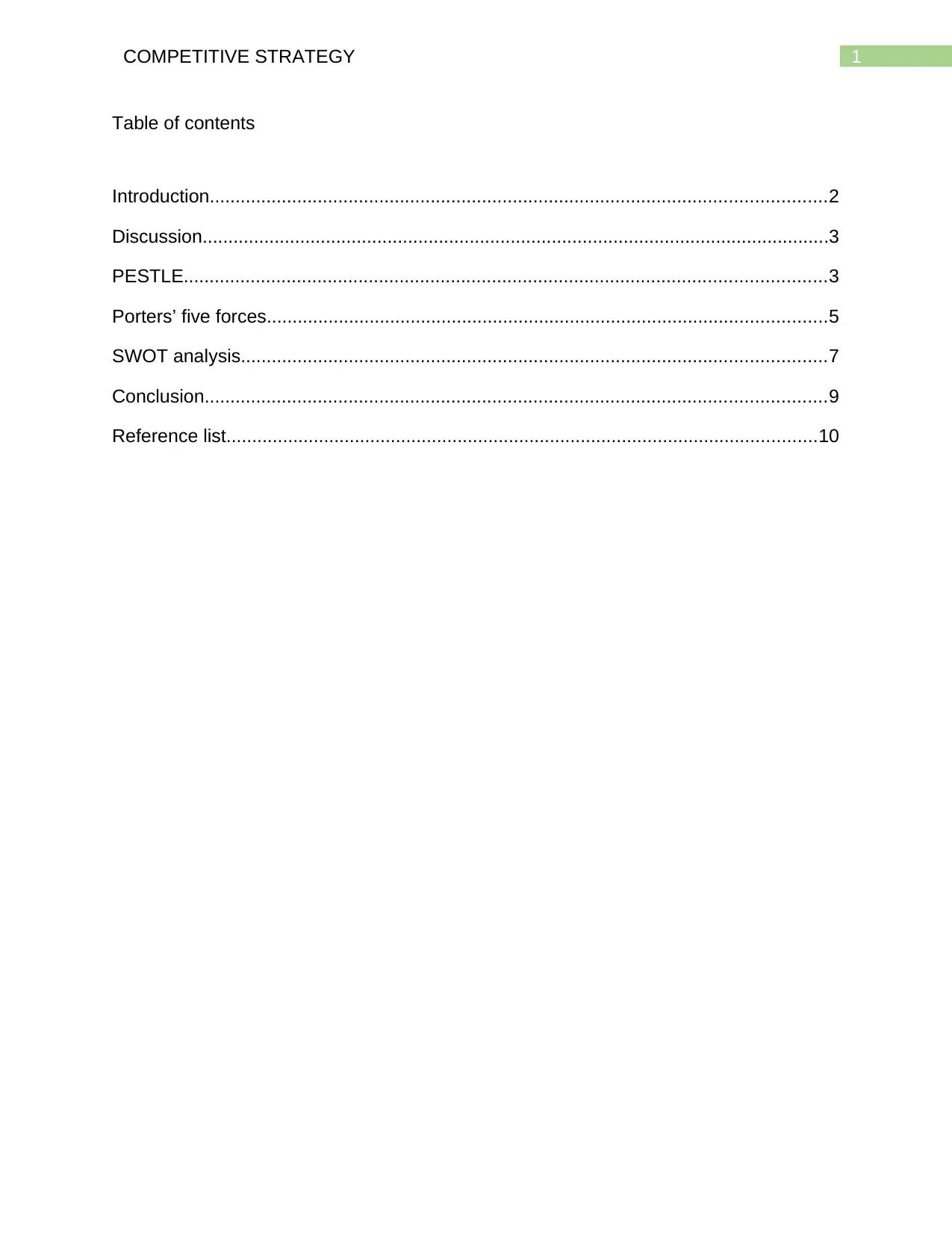
1COMPETITIVE STRATEGY
Table of contents
Introduction........................................................................................................................2
Discussion..........................................................................................................................3
PESTLE.............................................................................................................................3
Porters’ five forces.............................................................................................................5
SWOT analysis..................................................................................................................7
Conclusion.........................................................................................................................9
Reference list...................................................................................................................10
Table of contents
Introduction........................................................................................................................2
Discussion..........................................................................................................................3
PESTLE.............................................................................................................................3
Porters’ five forces.............................................................................................................5
SWOT analysis..................................................................................................................7
Conclusion.........................................................................................................................9
Reference list...................................................................................................................10
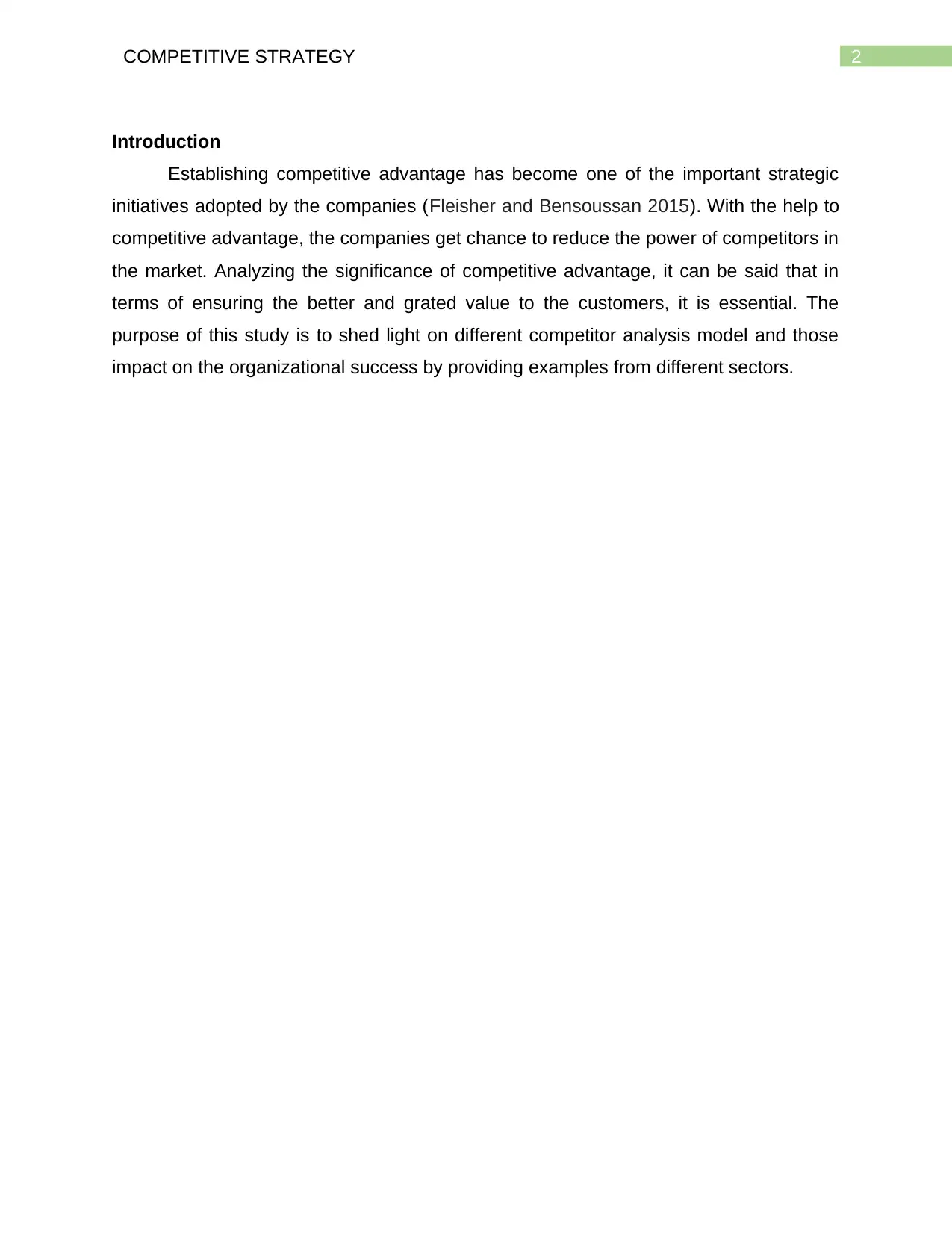
2COMPETITIVE STRATEGY
Introduction
Establishing competitive advantage has become one of the important strategic
initiatives adopted by the companies (Fleisher and Bensoussan 2015). With the help to
competitive advantage, the companies get chance to reduce the power of competitors in
the market. Analyzing the significance of competitive advantage, it can be said that in
terms of ensuring the better and grated value to the customers, it is essential. The
purpose of this study is to shed light on different competitor analysis model and those
impact on the organizational success by providing examples from different sectors.
Introduction
Establishing competitive advantage has become one of the important strategic
initiatives adopted by the companies (Fleisher and Bensoussan 2015). With the help to
competitive advantage, the companies get chance to reduce the power of competitors in
the market. Analyzing the significance of competitive advantage, it can be said that in
terms of ensuring the better and grated value to the customers, it is essential. The
purpose of this study is to shed light on different competitor analysis model and those
impact on the organizational success by providing examples from different sectors.
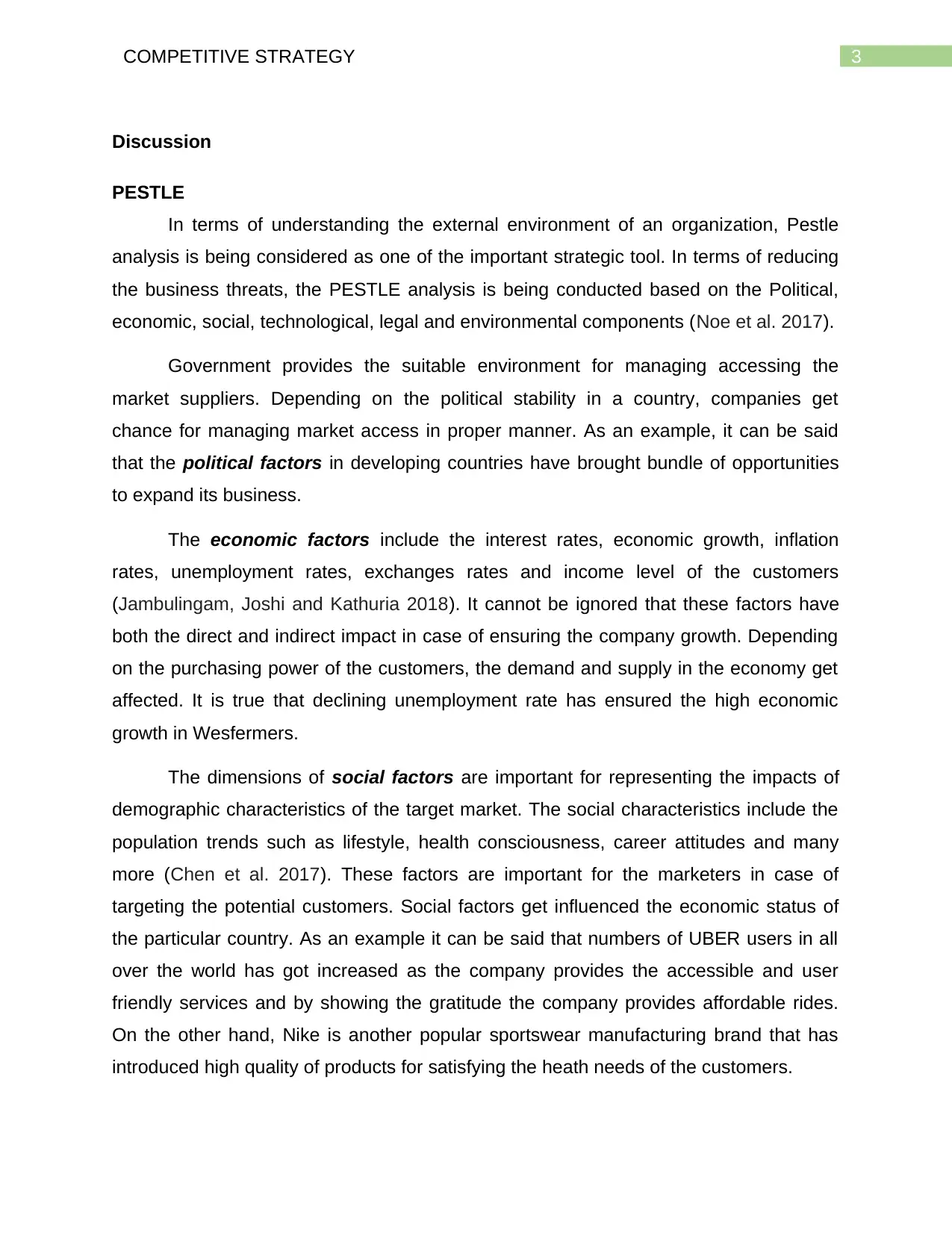
3COMPETITIVE STRATEGY
Discussion
PESTLE
In terms of understanding the external environment of an organization, Pestle
analysis is being considered as one of the important strategic tool. In terms of reducing
the business threats, the PESTLE analysis is being conducted based on the Political,
economic, social, technological, legal and environmental components (Noe et al. 2017).
Government provides the suitable environment for managing accessing the
market suppliers. Depending on the political stability in a country, companies get
chance for managing market access in proper manner. As an example, it can be said
that the political factors in developing countries have brought bundle of opportunities
to expand its business.
The economic factors include the interest rates, economic growth, inflation
rates, unemployment rates, exchanges rates and income level of the customers
(Jambulingam, Joshi and Kathuria 2018). It cannot be ignored that these factors have
both the direct and indirect impact in case of ensuring the company growth. Depending
on the purchasing power of the customers, the demand and supply in the economy get
affected. It is true that declining unemployment rate has ensured the high economic
growth in Wesfermers.
The dimensions of social factors are important for representing the impacts of
demographic characteristics of the target market. The social characteristics include the
population trends such as lifestyle, health consciousness, career attitudes and many
more (Chen et al. 2017). These factors are important for the marketers in case of
targeting the potential customers. Social factors get influenced the economic status of
the particular country. As an example it can be said that numbers of UBER users in all
over the world has got increased as the company provides the accessible and user
friendly services and by showing the gratitude the company provides affordable rides.
On the other hand, Nike is another popular sportswear manufacturing brand that has
introduced high quality of products for satisfying the heath needs of the customers.
Discussion
PESTLE
In terms of understanding the external environment of an organization, Pestle
analysis is being considered as one of the important strategic tool. In terms of reducing
the business threats, the PESTLE analysis is being conducted based on the Political,
economic, social, technological, legal and environmental components (Noe et al. 2017).
Government provides the suitable environment for managing accessing the
market suppliers. Depending on the political stability in a country, companies get
chance for managing market access in proper manner. As an example, it can be said
that the political factors in developing countries have brought bundle of opportunities
to expand its business.
The economic factors include the interest rates, economic growth, inflation
rates, unemployment rates, exchanges rates and income level of the customers
(Jambulingam, Joshi and Kathuria 2018). It cannot be ignored that these factors have
both the direct and indirect impact in case of ensuring the company growth. Depending
on the purchasing power of the customers, the demand and supply in the economy get
affected. It is true that declining unemployment rate has ensured the high economic
growth in Wesfermers.
The dimensions of social factors are important for representing the impacts of
demographic characteristics of the target market. The social characteristics include the
population trends such as lifestyle, health consciousness, career attitudes and many
more (Chen et al. 2017). These factors are important for the marketers in case of
targeting the potential customers. Social factors get influenced the economic status of
the particular country. As an example it can be said that numbers of UBER users in all
over the world has got increased as the company provides the accessible and user
friendly services and by showing the gratitude the company provides affordable rides.
On the other hand, Nike is another popular sportswear manufacturing brand that has
introduced high quality of products for satisfying the heath needs of the customers.
Secure Best Marks with AI Grader
Need help grading? Try our AI Grader for instant feedback on your assignments.
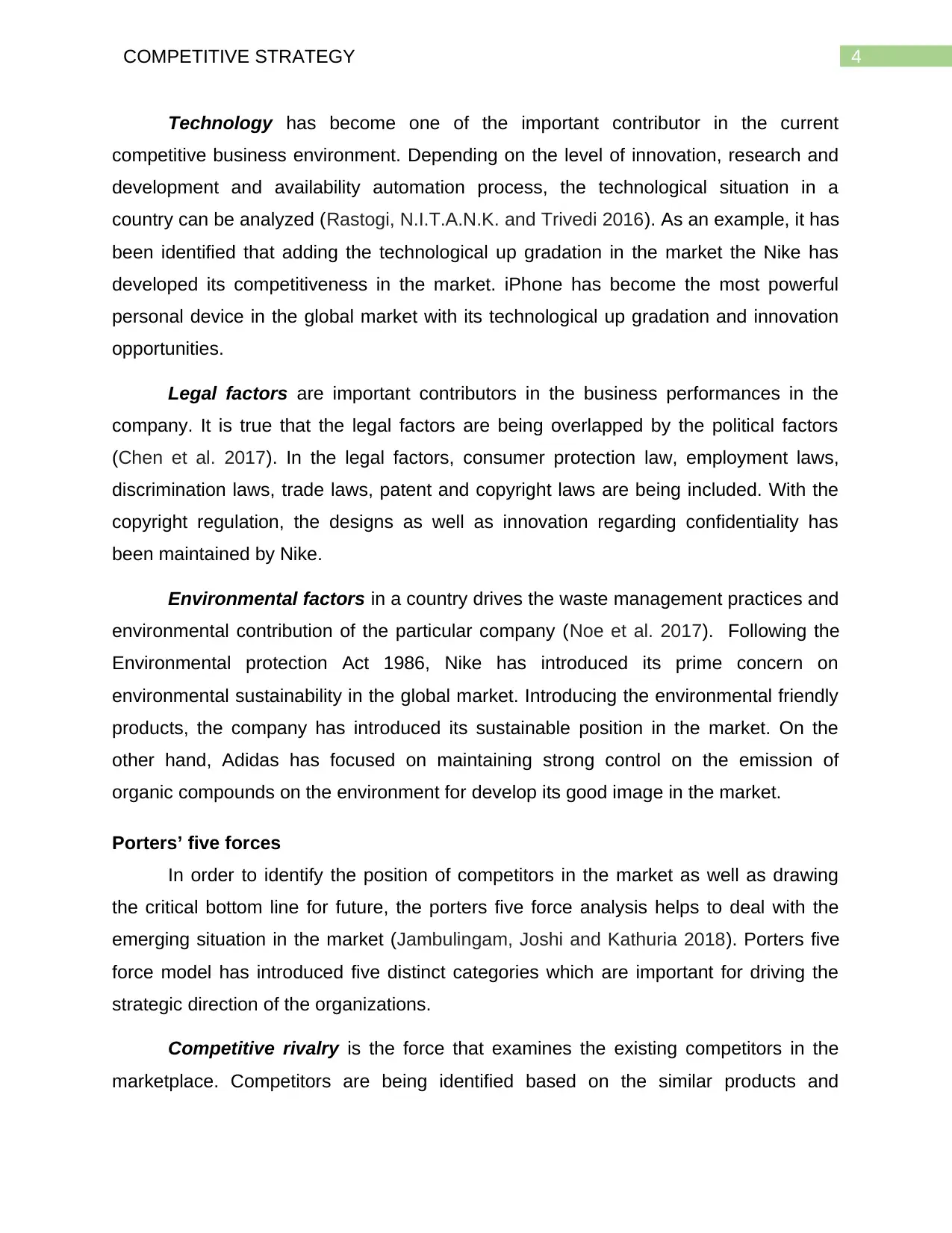
4COMPETITIVE STRATEGY
Technology has become one of the important contributor in the current
competitive business environment. Depending on the level of innovation, research and
development and availability automation process, the technological situation in a
country can be analyzed (Rastogi, N.I.T.A.N.K. and Trivedi 2016). As an example, it has
been identified that adding the technological up gradation in the market the Nike has
developed its competitiveness in the market. iPhone has become the most powerful
personal device in the global market with its technological up gradation and innovation
opportunities.
Legal factors are important contributors in the business performances in the
company. It is true that the legal factors are being overlapped by the political factors
(Chen et al. 2017). In the legal factors, consumer protection law, employment laws,
discrimination laws, trade laws, patent and copyright laws are being included. With the
copyright regulation, the designs as well as innovation regarding confidentiality has
been maintained by Nike.
Environmental factors in a country drives the waste management practices and
environmental contribution of the particular company (Noe et al. 2017). Following the
Environmental protection Act 1986, Nike has introduced its prime concern on
environmental sustainability in the global market. Introducing the environmental friendly
products, the company has introduced its sustainable position in the market. On the
other hand, Adidas has focused on maintaining strong control on the emission of
organic compounds on the environment for develop its good image in the market.
Porters’ five forces
In order to identify the position of competitors in the market as well as drawing
the critical bottom line for future, the porters five force analysis helps to deal with the
emerging situation in the market (Jambulingam, Joshi and Kathuria 2018). Porters five
force model has introduced five distinct categories which are important for driving the
strategic direction of the organizations.
Competitive rivalry is the force that examines the existing competitors in the
marketplace. Competitors are being identified based on the similar products and
Technology has become one of the important contributor in the current
competitive business environment. Depending on the level of innovation, research and
development and availability automation process, the technological situation in a
country can be analyzed (Rastogi, N.I.T.A.N.K. and Trivedi 2016). As an example, it has
been identified that adding the technological up gradation in the market the Nike has
developed its competitiveness in the market. iPhone has become the most powerful
personal device in the global market with its technological up gradation and innovation
opportunities.
Legal factors are important contributors in the business performances in the
company. It is true that the legal factors are being overlapped by the political factors
(Chen et al. 2017). In the legal factors, consumer protection law, employment laws,
discrimination laws, trade laws, patent and copyright laws are being included. With the
copyright regulation, the designs as well as innovation regarding confidentiality has
been maintained by Nike.
Environmental factors in a country drives the waste management practices and
environmental contribution of the particular company (Noe et al. 2017). Following the
Environmental protection Act 1986, Nike has introduced its prime concern on
environmental sustainability in the global market. Introducing the environmental friendly
products, the company has introduced its sustainable position in the market. On the
other hand, Adidas has focused on maintaining strong control on the emission of
organic compounds on the environment for develop its good image in the market.
Porters’ five forces
In order to identify the position of competitors in the market as well as drawing
the critical bottom line for future, the porters five force analysis helps to deal with the
emerging situation in the market (Jambulingam, Joshi and Kathuria 2018). Porters five
force model has introduced five distinct categories which are important for driving the
strategic direction of the organizations.
Competitive rivalry is the force that examines the existing competitors in the
marketplace. Competitors are being identified based on the similar products and
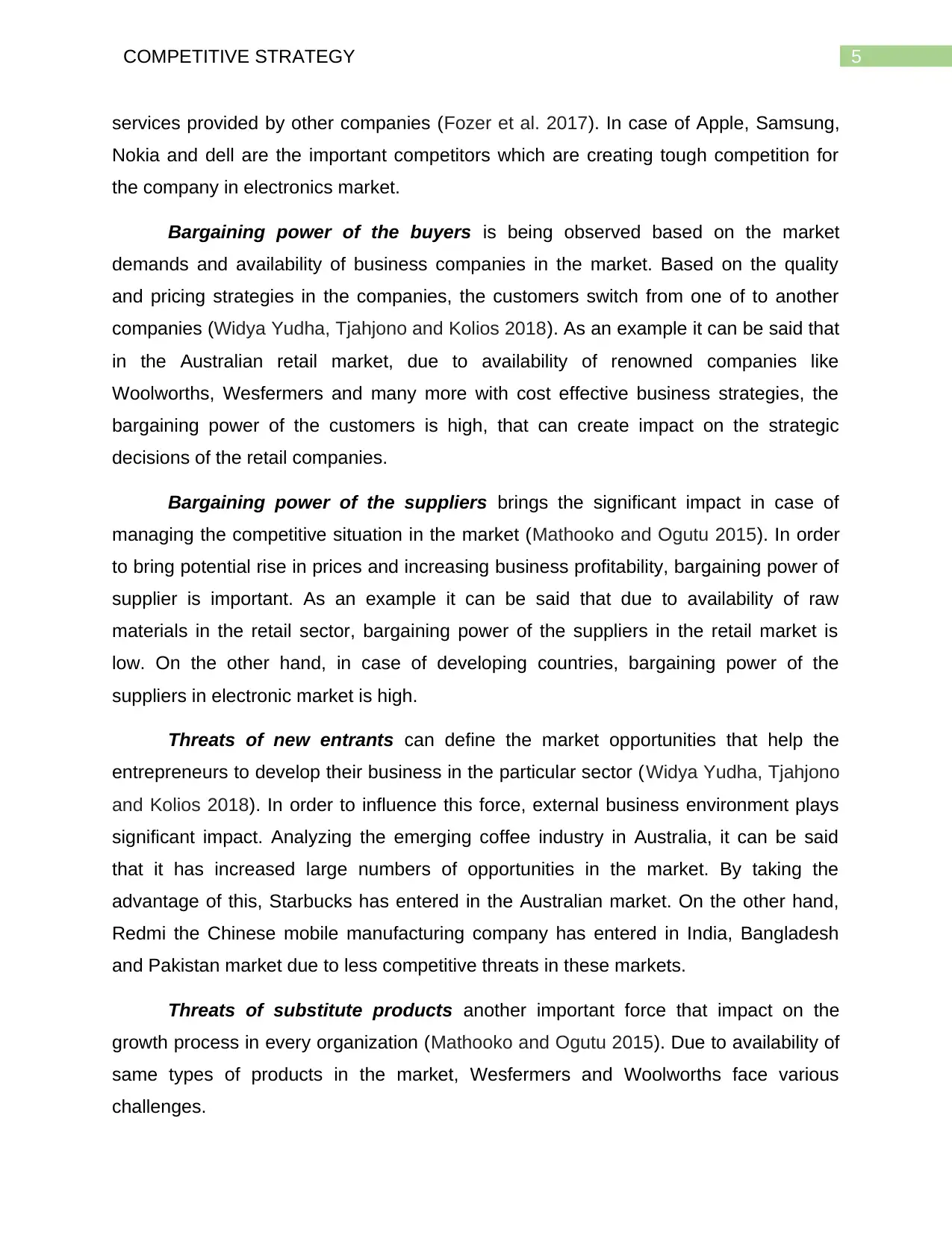
5COMPETITIVE STRATEGY
services provided by other companies (Fozer et al. 2017). In case of Apple, Samsung,
Nokia and dell are the important competitors which are creating tough competition for
the company in electronics market.
Bargaining power of the buyers is being observed based on the market
demands and availability of business companies in the market. Based on the quality
and pricing strategies in the companies, the customers switch from one of to another
companies (Widya Yudha, Tjahjono and Kolios 2018). As an example it can be said that
in the Australian retail market, due to availability of renowned companies like
Woolworths, Wesfermers and many more with cost effective business strategies, the
bargaining power of the customers is high, that can create impact on the strategic
decisions of the retail companies.
Bargaining power of the suppliers brings the significant impact in case of
managing the competitive situation in the market (Mathooko and Ogutu 2015). In order
to bring potential rise in prices and increasing business profitability, bargaining power of
supplier is important. As an example it can be said that due to availability of raw
materials in the retail sector, bargaining power of the suppliers in the retail market is
low. On the other hand, in case of developing countries, bargaining power of the
suppliers in electronic market is high.
Threats of new entrants can define the market opportunities that help the
entrepreneurs to develop their business in the particular sector (Widya Yudha, Tjahjono
and Kolios 2018). In order to influence this force, external business environment plays
significant impact. Analyzing the emerging coffee industry in Australia, it can be said
that it has increased large numbers of opportunities in the market. By taking the
advantage of this, Starbucks has entered in the Australian market. On the other hand,
Redmi the Chinese mobile manufacturing company has entered in India, Bangladesh
and Pakistan market due to less competitive threats in these markets.
Threats of substitute products another important force that impact on the
growth process in every organization (Mathooko and Ogutu 2015). Due to availability of
same types of products in the market, Wesfermers and Woolworths face various
challenges.
services provided by other companies (Fozer et al. 2017). In case of Apple, Samsung,
Nokia and dell are the important competitors which are creating tough competition for
the company in electronics market.
Bargaining power of the buyers is being observed based on the market
demands and availability of business companies in the market. Based on the quality
and pricing strategies in the companies, the customers switch from one of to another
companies (Widya Yudha, Tjahjono and Kolios 2018). As an example it can be said that
in the Australian retail market, due to availability of renowned companies like
Woolworths, Wesfermers and many more with cost effective business strategies, the
bargaining power of the customers is high, that can create impact on the strategic
decisions of the retail companies.
Bargaining power of the suppliers brings the significant impact in case of
managing the competitive situation in the market (Mathooko and Ogutu 2015). In order
to bring potential rise in prices and increasing business profitability, bargaining power of
supplier is important. As an example it can be said that due to availability of raw
materials in the retail sector, bargaining power of the suppliers in the retail market is
low. On the other hand, in case of developing countries, bargaining power of the
suppliers in electronic market is high.
Threats of new entrants can define the market opportunities that help the
entrepreneurs to develop their business in the particular sector (Widya Yudha, Tjahjono
and Kolios 2018). In order to influence this force, external business environment plays
significant impact. Analyzing the emerging coffee industry in Australia, it can be said
that it has increased large numbers of opportunities in the market. By taking the
advantage of this, Starbucks has entered in the Australian market. On the other hand,
Redmi the Chinese mobile manufacturing company has entered in India, Bangladesh
and Pakistan market due to less competitive threats in these markets.
Threats of substitute products another important force that impact on the
growth process in every organization (Mathooko and Ogutu 2015). Due to availability of
same types of products in the market, Wesfermers and Woolworths face various
challenges.
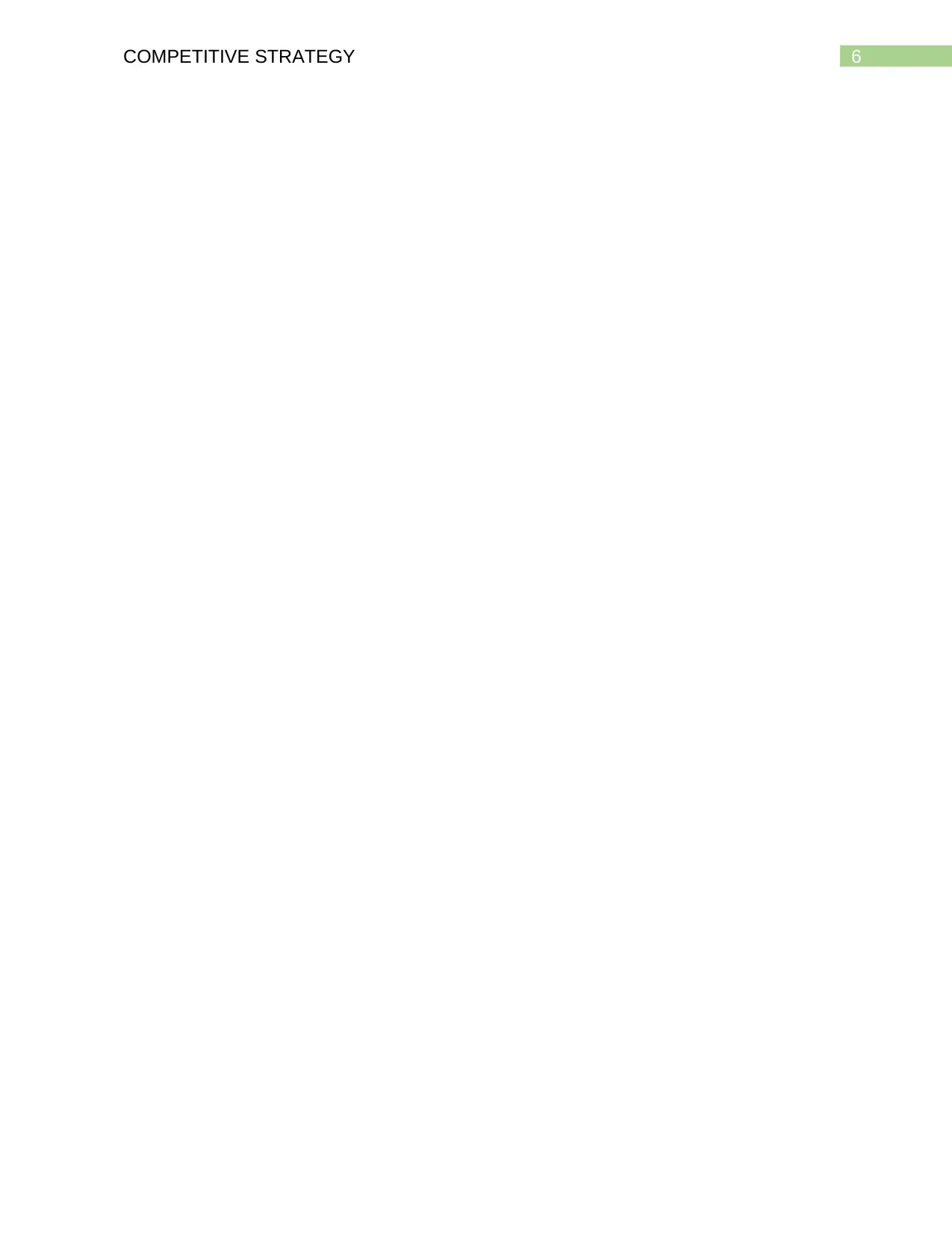
6COMPETITIVE STRATEGY
Paraphrase This Document
Need a fresh take? Get an instant paraphrase of this document with our AI Paraphraser
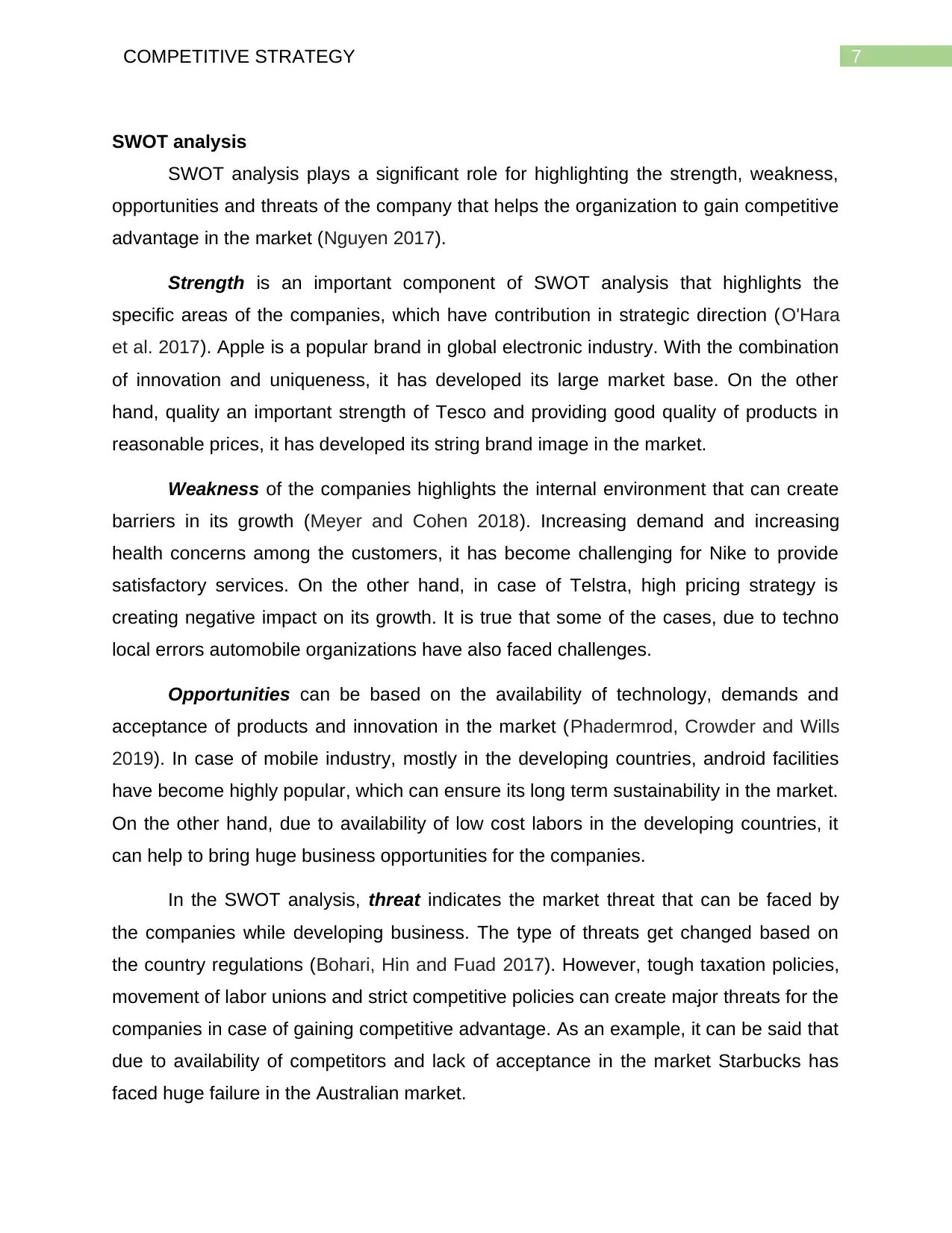
7COMPETITIVE STRATEGY
SWOT analysis
SWOT analysis plays a significant role for highlighting the strength, weakness,
opportunities and threats of the company that helps the organization to gain competitive
advantage in the market (Nguyen 2017).
Strength is an important component of SWOT analysis that highlights the
specific areas of the companies, which have contribution in strategic direction (O'Hara
et al. 2017). Apple is a popular brand in global electronic industry. With the combination
of innovation and uniqueness, it has developed its large market base. On the other
hand, quality an important strength of Tesco and providing good quality of products in
reasonable prices, it has developed its string brand image in the market.
Weakness of the companies highlights the internal environment that can create
barriers in its growth (Meyer and Cohen 2018). Increasing demand and increasing
health concerns among the customers, it has become challenging for Nike to provide
satisfactory services. On the other hand, in case of Telstra, high pricing strategy is
creating negative impact on its growth. It is true that some of the cases, due to techno
local errors automobile organizations have also faced challenges.
Opportunities can be based on the availability of technology, demands and
acceptance of products and innovation in the market (Phadermrod, Crowder and Wills
2019). In case of mobile industry, mostly in the developing countries, android facilities
have become highly popular, which can ensure its long term sustainability in the market.
On the other hand, due to availability of low cost labors in the developing countries, it
can help to bring huge business opportunities for the companies.
In the SWOT analysis, threat indicates the market threat that can be faced by
the companies while developing business. The type of threats get changed based on
the country regulations (Bohari, Hin and Fuad 2017). However, tough taxation policies,
movement of labor unions and strict competitive policies can create major threats for the
companies in case of gaining competitive advantage. As an example, it can be said that
due to availability of competitors and lack of acceptance in the market Starbucks has
faced huge failure in the Australian market.
SWOT analysis
SWOT analysis plays a significant role for highlighting the strength, weakness,
opportunities and threats of the company that helps the organization to gain competitive
advantage in the market (Nguyen 2017).
Strength is an important component of SWOT analysis that highlights the
specific areas of the companies, which have contribution in strategic direction (O'Hara
et al. 2017). Apple is a popular brand in global electronic industry. With the combination
of innovation and uniqueness, it has developed its large market base. On the other
hand, quality an important strength of Tesco and providing good quality of products in
reasonable prices, it has developed its string brand image in the market.
Weakness of the companies highlights the internal environment that can create
barriers in its growth (Meyer and Cohen 2018). Increasing demand and increasing
health concerns among the customers, it has become challenging for Nike to provide
satisfactory services. On the other hand, in case of Telstra, high pricing strategy is
creating negative impact on its growth. It is true that some of the cases, due to techno
local errors automobile organizations have also faced challenges.
Opportunities can be based on the availability of technology, demands and
acceptance of products and innovation in the market (Phadermrod, Crowder and Wills
2019). In case of mobile industry, mostly in the developing countries, android facilities
have become highly popular, which can ensure its long term sustainability in the market.
On the other hand, due to availability of low cost labors in the developing countries, it
can help to bring huge business opportunities for the companies.
In the SWOT analysis, threat indicates the market threat that can be faced by
the companies while developing business. The type of threats get changed based on
the country regulations (Bohari, Hin and Fuad 2017). However, tough taxation policies,
movement of labor unions and strict competitive policies can create major threats for the
companies in case of gaining competitive advantage. As an example, it can be said that
due to availability of competitors and lack of acceptance in the market Starbucks has
faced huge failure in the Australian market.
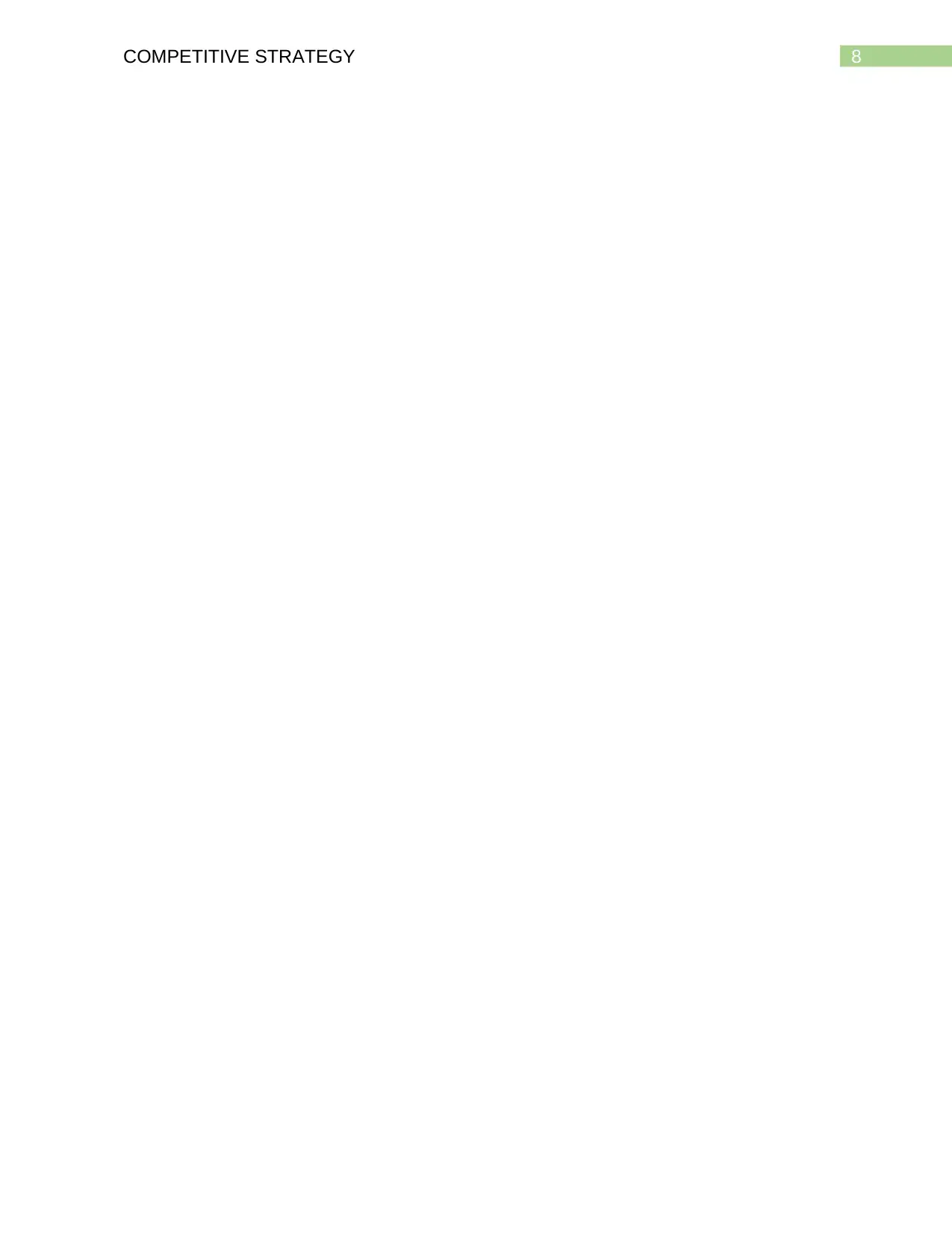
8COMPETITIVE STRATEGY
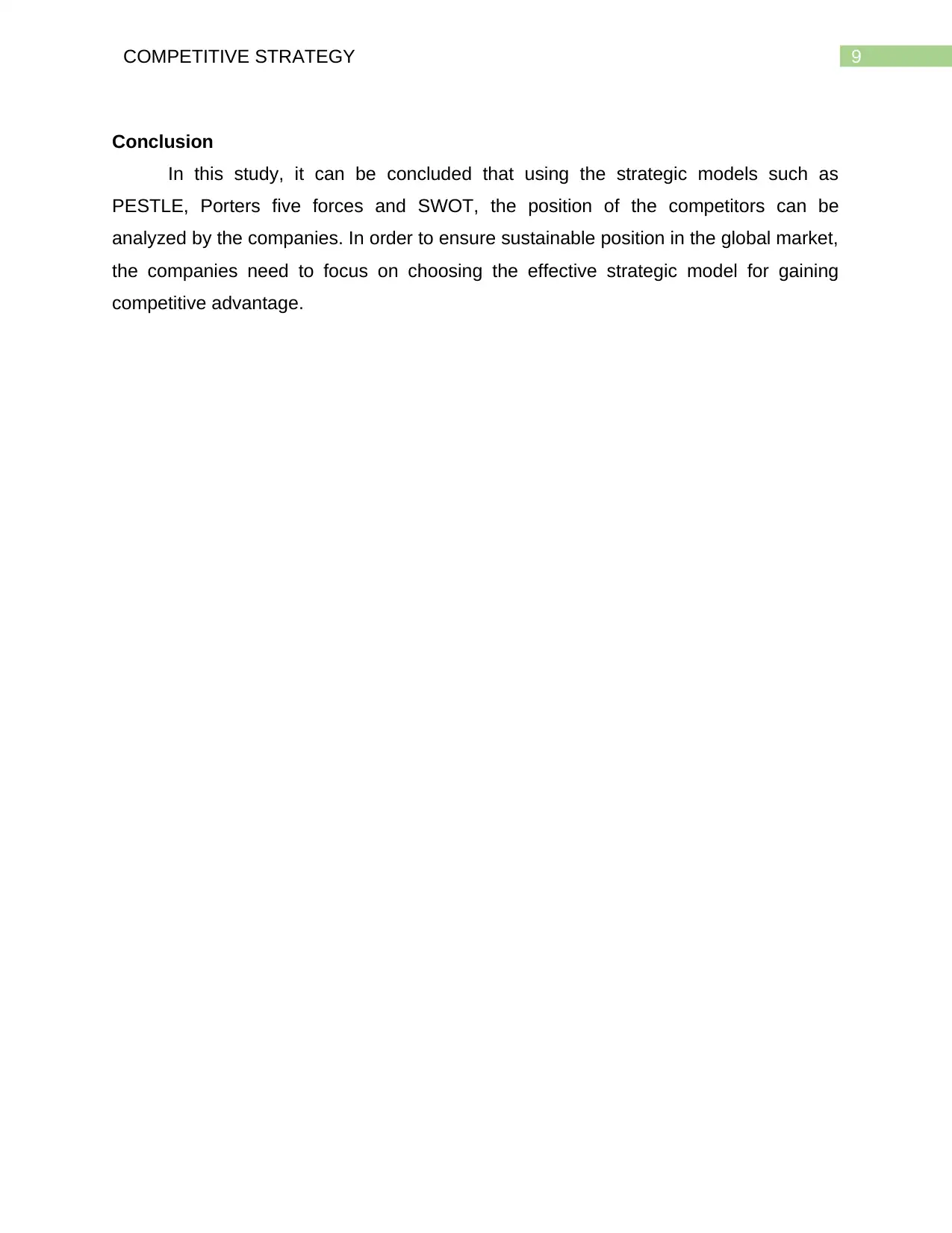
9COMPETITIVE STRATEGY
Conclusion
In this study, it can be concluded that using the strategic models such as
PESTLE, Porters five forces and SWOT, the position of the competitors can be
analyzed by the companies. In order to ensure sustainable position in the global market,
the companies need to focus on choosing the effective strategic model for gaining
competitive advantage.
Conclusion
In this study, it can be concluded that using the strategic models such as
PESTLE, Porters five forces and SWOT, the position of the competitors can be
analyzed by the companies. In order to ensure sustainable position in the global market,
the companies need to focus on choosing the effective strategic model for gaining
competitive advantage.
Secure Best Marks with AI Grader
Need help grading? Try our AI Grader for instant feedback on your assignments.
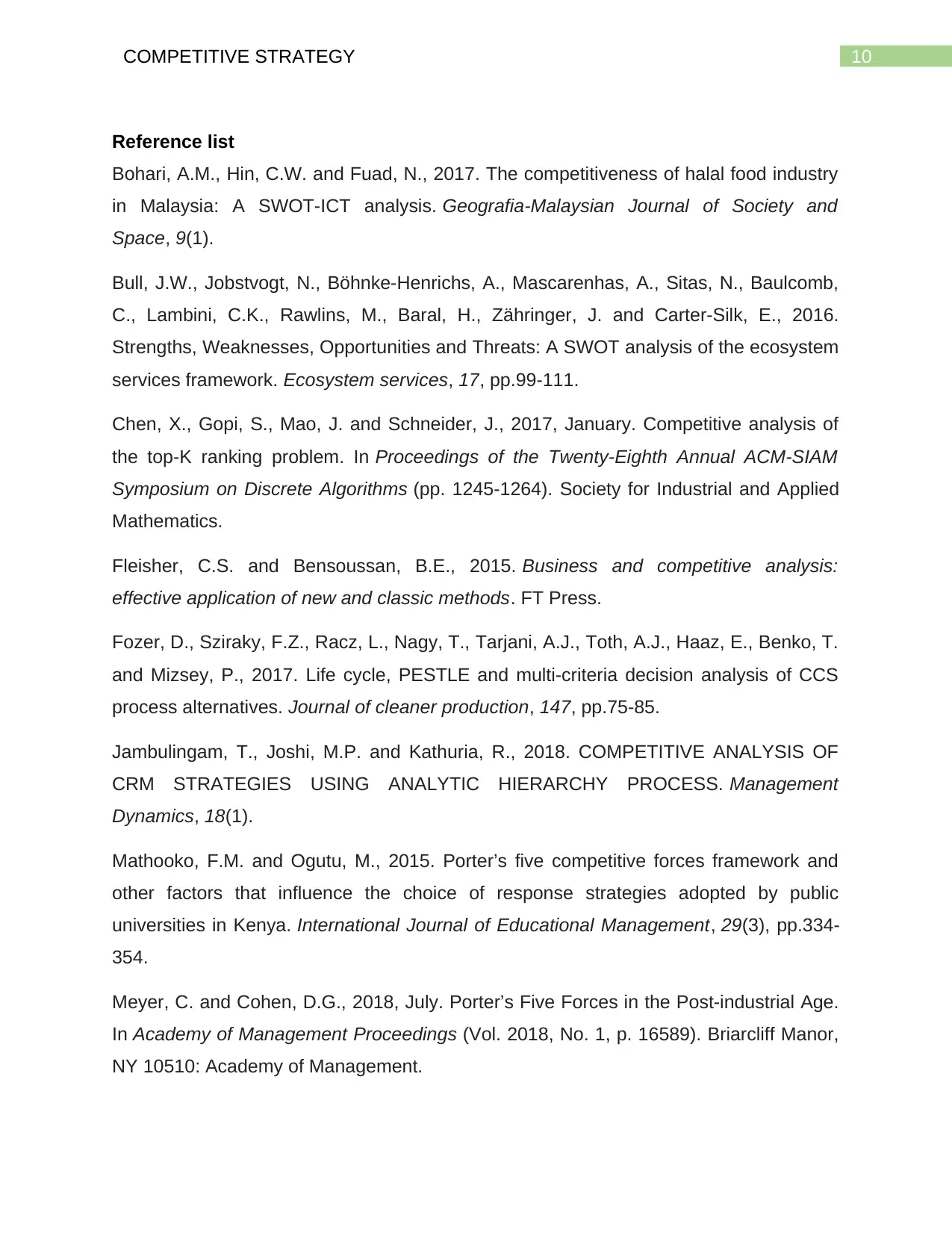
10COMPETITIVE STRATEGY
Reference list
Bohari, A.M., Hin, C.W. and Fuad, N., 2017. The competitiveness of halal food industry
in Malaysia: A SWOT-ICT analysis. Geografia-Malaysian Journal of Society and
Space, 9(1).
Bull, J.W., Jobstvogt, N., Böhnke-Henrichs, A., Mascarenhas, A., Sitas, N., Baulcomb,
C., Lambini, C.K., Rawlins, M., Baral, H., Zähringer, J. and Carter-Silk, E., 2016.
Strengths, Weaknesses, Opportunities and Threats: A SWOT analysis of the ecosystem
services framework. Ecosystem services, 17, pp.99-111.
Chen, X., Gopi, S., Mao, J. and Schneider, J., 2017, January. Competitive analysis of
the top-K ranking problem. In Proceedings of the Twenty-Eighth Annual ACM-SIAM
Symposium on Discrete Algorithms (pp. 1245-1264). Society for Industrial and Applied
Mathematics.
Fleisher, C.S. and Bensoussan, B.E., 2015. Business and competitive analysis:
effective application of new and classic methods. FT Press.
Fozer, D., Sziraky, F.Z., Racz, L., Nagy, T., Tarjani, A.J., Toth, A.J., Haaz, E., Benko, T.
and Mizsey, P., 2017. Life cycle, PESTLE and multi-criteria decision analysis of CCS
process alternatives. Journal of cleaner production, 147, pp.75-85.
Jambulingam, T., Joshi, M.P. and Kathuria, R., 2018. COMPETITIVE ANALYSIS OF
CRM STRATEGIES USING ANALYTIC HIERARCHY PROCESS. Management
Dynamics, 18(1).
Mathooko, F.M. and Ogutu, M., 2015. Porter’s five competitive forces framework and
other factors that influence the choice of response strategies adopted by public
universities in Kenya. International Journal of Educational Management, 29(3), pp.334-
354.
Meyer, C. and Cohen, D.G., 2018, July. Porter’s Five Forces in the Post-industrial Age.
In Academy of Management Proceedings (Vol. 2018, No. 1, p. 16589). Briarcliff Manor,
NY 10510: Academy of Management.
Reference list
Bohari, A.M., Hin, C.W. and Fuad, N., 2017. The competitiveness of halal food industry
in Malaysia: A SWOT-ICT analysis. Geografia-Malaysian Journal of Society and
Space, 9(1).
Bull, J.W., Jobstvogt, N., Böhnke-Henrichs, A., Mascarenhas, A., Sitas, N., Baulcomb,
C., Lambini, C.K., Rawlins, M., Baral, H., Zähringer, J. and Carter-Silk, E., 2016.
Strengths, Weaknesses, Opportunities and Threats: A SWOT analysis of the ecosystem
services framework. Ecosystem services, 17, pp.99-111.
Chen, X., Gopi, S., Mao, J. and Schneider, J., 2017, January. Competitive analysis of
the top-K ranking problem. In Proceedings of the Twenty-Eighth Annual ACM-SIAM
Symposium on Discrete Algorithms (pp. 1245-1264). Society for Industrial and Applied
Mathematics.
Fleisher, C.S. and Bensoussan, B.E., 2015. Business and competitive analysis:
effective application of new and classic methods. FT Press.
Fozer, D., Sziraky, F.Z., Racz, L., Nagy, T., Tarjani, A.J., Toth, A.J., Haaz, E., Benko, T.
and Mizsey, P., 2017. Life cycle, PESTLE and multi-criteria decision analysis of CCS
process alternatives. Journal of cleaner production, 147, pp.75-85.
Jambulingam, T., Joshi, M.P. and Kathuria, R., 2018. COMPETITIVE ANALYSIS OF
CRM STRATEGIES USING ANALYTIC HIERARCHY PROCESS. Management
Dynamics, 18(1).
Mathooko, F.M. and Ogutu, M., 2015. Porter’s five competitive forces framework and
other factors that influence the choice of response strategies adopted by public
universities in Kenya. International Journal of Educational Management, 29(3), pp.334-
354.
Meyer, C. and Cohen, D.G., 2018, July. Porter’s Five Forces in the Post-industrial Age.
In Academy of Management Proceedings (Vol. 2018, No. 1, p. 16589). Briarcliff Manor,
NY 10510: Academy of Management.
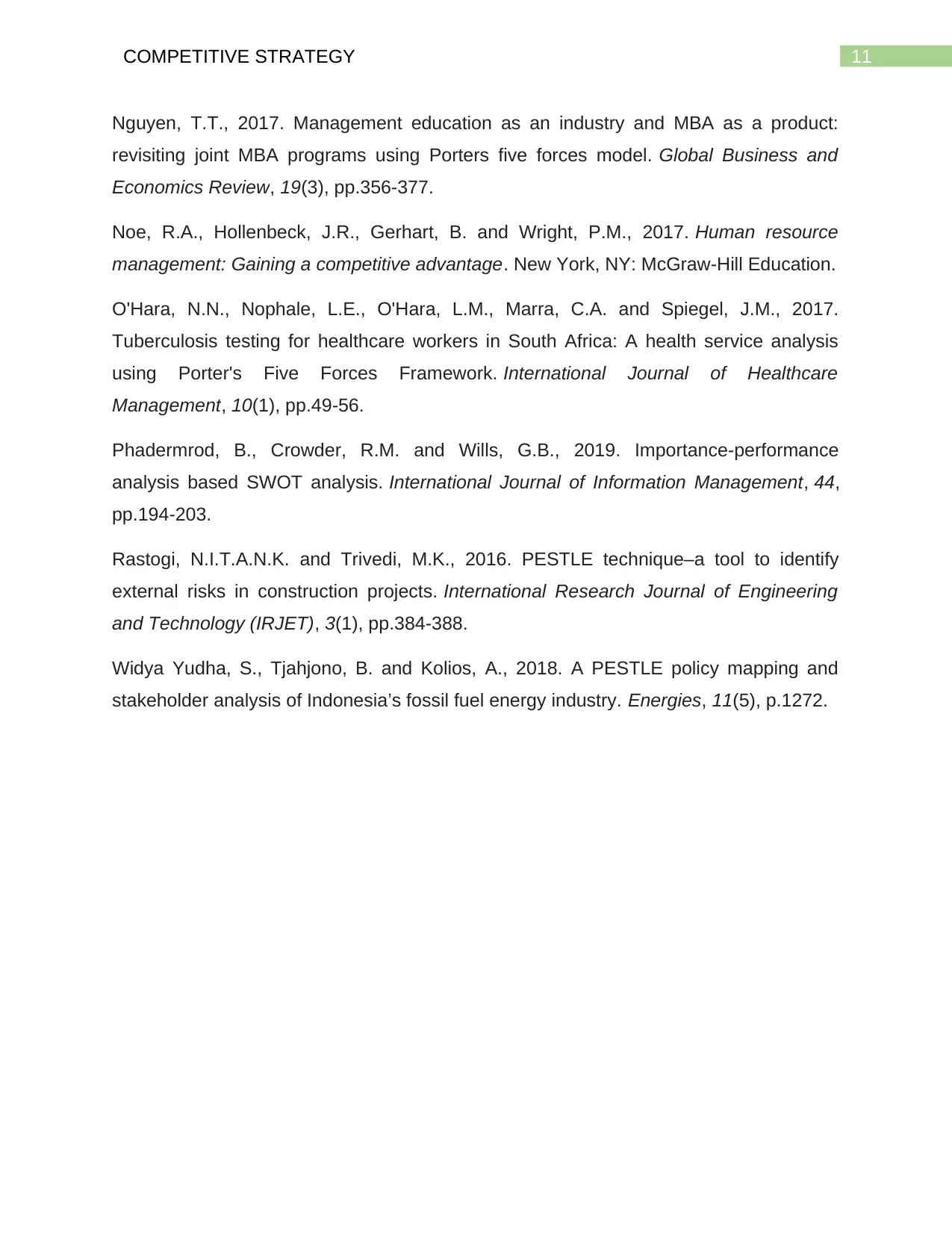
11COMPETITIVE STRATEGY
Nguyen, T.T., 2017. Management education as an industry and MBA as a product:
revisiting joint MBA programs using Porters five forces model. Global Business and
Economics Review, 19(3), pp.356-377.
Noe, R.A., Hollenbeck, J.R., Gerhart, B. and Wright, P.M., 2017. Human resource
management: Gaining a competitive advantage. New York, NY: McGraw-Hill Education.
O'Hara, N.N., Nophale, L.E., O'Hara, L.M., Marra, C.A. and Spiegel, J.M., 2017.
Tuberculosis testing for healthcare workers in South Africa: A health service analysis
using Porter's Five Forces Framework. International Journal of Healthcare
Management, 10(1), pp.49-56.
Phadermrod, B., Crowder, R.M. and Wills, G.B., 2019. Importance-performance
analysis based SWOT analysis. International Journal of Information Management, 44,
pp.194-203.
Rastogi, N.I.T.A.N.K. and Trivedi, M.K., 2016. PESTLE technique–a tool to identify
external risks in construction projects. International Research Journal of Engineering
and Technology (IRJET), 3(1), pp.384-388.
Widya Yudha, S., Tjahjono, B. and Kolios, A., 2018. A PESTLE policy mapping and
stakeholder analysis of Indonesia’s fossil fuel energy industry. Energies, 11(5), p.1272.
Nguyen, T.T., 2017. Management education as an industry and MBA as a product:
revisiting joint MBA programs using Porters five forces model. Global Business and
Economics Review, 19(3), pp.356-377.
Noe, R.A., Hollenbeck, J.R., Gerhart, B. and Wright, P.M., 2017. Human resource
management: Gaining a competitive advantage. New York, NY: McGraw-Hill Education.
O'Hara, N.N., Nophale, L.E., O'Hara, L.M., Marra, C.A. and Spiegel, J.M., 2017.
Tuberculosis testing for healthcare workers in South Africa: A health service analysis
using Porter's Five Forces Framework. International Journal of Healthcare
Management, 10(1), pp.49-56.
Phadermrod, B., Crowder, R.M. and Wills, G.B., 2019. Importance-performance
analysis based SWOT analysis. International Journal of Information Management, 44,
pp.194-203.
Rastogi, N.I.T.A.N.K. and Trivedi, M.K., 2016. PESTLE technique–a tool to identify
external risks in construction projects. International Research Journal of Engineering
and Technology (IRJET), 3(1), pp.384-388.
Widya Yudha, S., Tjahjono, B. and Kolios, A., 2018. A PESTLE policy mapping and
stakeholder analysis of Indonesia’s fossil fuel energy industry. Energies, 11(5), p.1272.
1 out of 12
Related Documents
Your All-in-One AI-Powered Toolkit for Academic Success.
+13062052269
info@desklib.com
Available 24*7 on WhatsApp / Email
![[object Object]](/_next/static/media/star-bottom.7253800d.svg)
Unlock your academic potential
© 2024 | Zucol Services PVT LTD | All rights reserved.




